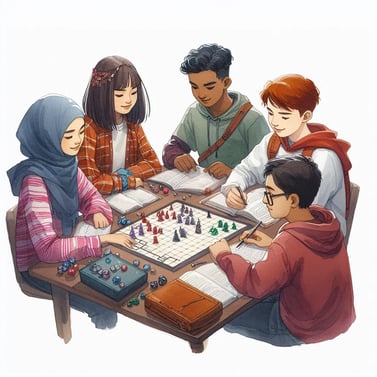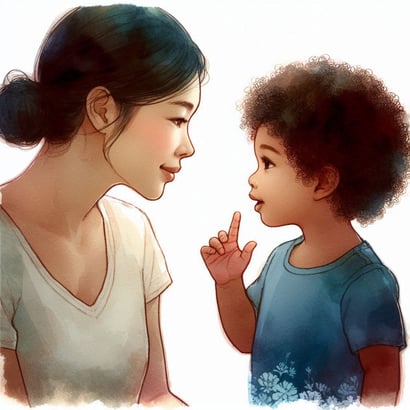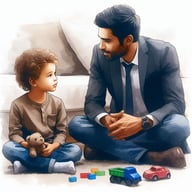
Should I tell my child about their autism diagnosis?
Many parents worry about telling their child about their autism diagnosis. They worry about stigma and question how much their child will understand (Almog et al., 2022; Riccio et al., 2020). This parent resource uses a research-based approach to answer the question, it will look at parental disclosure and its association with autistic identity. Every parent must inevitably decide what they feel is best for their family, this information will hopefully help them make a more informed decision.
Parental Disclosure
Assessments
Intervention
FAQ
References
Scroll down to view or click on pictures to view in a slideshow.
Parental Disclosure
Autistic identity can be thought of as how a person views their autism in relation to themselves. Having a negative autistic identity is associated with low self-esteem and higher rates of mental health issues compared to those with a positive autistic identity (Cooper et al., 2022). Now if your thinking, if my child doesn’t know they are autistic will this impact them? The answer is yes. To illustrate how this can impact your child we will look at it through a life path, on one path a child is told about their diagnosis while on the other they are not.


While you may not have told your child that they are autistic, there’s a good chance they suspect they are somehow different. Autistic adolescent and adult research participants describe a sense of knowing they were different even though their parents had not disclosed their diagnosis (Riccio et al., 2020). On our life path the child that knows they are autistic will develop with autism as part of their identity. The child that has not been told about their diagnosis starts to realize that they are somehow different from peers but are uncertain why.




Unfortunately, autistic children are more likely to face peer rejection and bullying than their neurotypical peers (Tesfaye et al., 2022). These decisions are based on peers first impressions not a known diagnosis (Sasson et al., 2017). Research on communication has shown that autistics communicate differently (Crompton et al., 2020), and this will impact those first impressions. The child on the life path not knowing their diagnosis may develop feelings of shame leading to low self-esteem, and negative self-perspective. Meanwhile child that knows they're autistic has opportunity to learn about their autism and access supports. As both autistic children move into adolescence this early understanding of themselves is a foundation that their identity will be built on (Oredipe et al., 2022).


In adolescence not knowing about their diagnosis can make a child feel as though they do not fit in which can lead to masking (Riccio et al., 2020). Masking is when an autistic person suppresses their autistic traits in an attempt to meet group norms (Crompton et al., 2020), it is associated with low self-esteem, anxiety, and mental health problems (Remnélius & Bölte, 2023). Despite parents not disclosing a diagnosis, many children find out from other sources or figure it out on their own. A new branch on this life path emerges when a child learns about their autism from a source other than their parents. They may feel relieved by the new understanding of themselves (Almog et al., 2024) but they may assume their parents think negatively about autism due to nondisclosure and start to develop a negative autistic identity (Riccio et al., 2020).


A child who knows their diagnosis has access to groups for autistic youth leading to opportunities for friendships (Oredipe et al., 2022). They may learn strategies that help with things they find difficult and find ways to better understand themselves (Almog et al., 2024) They will still face obstacles, but knowledge of their autism can lead to less exclusion and greater social connectedness in adulthood (Maitland et al., 2021) Not knowing about diagnosis, a child misses out on opportunities to be part of the autistic community and positive autistic experiences with peers that have similar life experiences (Corden et al., 2021).


The research suggests that it is best to tell your child soon after their diagnosis as longer delay between diagnosis and parental disclosure is associated with more negative mental health issues and lower quality of life in adulthood (Almog et al., 2024; Oredipe et al., 2022). A parent may be well intentioned, but as described here not disclosing a diagnosis has more negatives than positives. Your child is going to face obstacles regardless of whether you tell them about their autism, knowing about their diagnosis provides the opportunity to follow a life path where they develop a positive autistic identity and live life on their terms (Tesfaye et al., 2022).
Assessments
I never appreciated the time and effort that must go into making an assessment with good validity until I started researching for this article. By validity I mean an assessments ability to measure what it is supposed to measure. When using assessments for autistic youth it is important to use assessments designed for autistic people, which is not always the case. In a study using common anxiety assessments with autistic youth, Kaat & Lecavalier (2015), found that these tests did not produce consistent results with autistic youth and accuracy depended on IQ and how autistic traits presented.
What follows are some assessments that have been shown to be valid for use with autistic youth. The cost of assessments can be a barrier for many families, so the focus here are assessments that are available online. This comes with a disclaimer. These tests require medical expertise to properly understand the scoring implications (Groden et al., 2001); however, reviewing these tests may provide a parent with additional perspective or new questions to think about. They may provide a basis for you to engage your child in conversation about their autism. If after reviewing these tests you have concerns, you should discuss those concerns with a health professional in your child’s support team.


This assessment is completed by a parent or somebody else close to the child, measures the evaluator’s perception of a child’s stress and is valid for use with autistic and other neurodivergent children. This test is not about identity or social connectedness so you might be wondering why I would include this one. There are three reasons. First, high stress and anxiety can result from not fitting in with peers. Second, it can be used with children from 6-19 reaching a younger age group than the other tests I mention. Lastly there are versions of the test online. Reviewing the questions and thinking about your child in relation to the questions may provide insight.
Details:
For use with youth 6-19
5-point Likert scale
1 (none to mild)
5 severe
· Is the evaluator’s perception of a child’s stress.


This is a self-report measure was developed for the general population but has been found to be valid for use with autistic youth 12-19 years old (Shogren et al., 2019). The assessment has 24 questions that fall into six scoring categories (Van der Kaap-Deeder et al., 2020).
Details:
For use with general population including autistic youth 12-19
· Uses 5-point Likert scale
1 Completely not true
5 Completely True
measures psychological satisfaction and frustration in achieving psychological needs of autonomy, relatedness, and competence (Shogren et al., 2019).


The SCSR is not a test specifically designed for use with autistic youth but has been used in clinical settings with the autistic youth as young as 12 (Schwartzman & Bettis, 2024). This test is often used with other assessments to give a fuller picture of connectedness. It has a sliding scale with lower scores showing less community connectedness. It is one of many tests available for free on the YouthREX website.
Details:
For use with youth 14-18
· 6-point Likert scale
1 strongly agree
6 strongly disagree
Assesses a youth’s sense of community connectedness.


This is a self report questionnaire that measures masking traits. As masking is associated with negative mental health outcomes this can be a useful test. The test is commonly used to detect autism masking in undiagnosed adults. The test is valid for use with people 16 and older. Some studies have tried to use the test with autistic youth under 16 but found that the validity failed entirely for youth under 14 years of age. Does this mean it can be used with 14- and 15-year-olds? Not at this time. There may be adapted versions that come out in the future but at this time the test is valid for those 16+.
Details:
For use with 16 +
· 7-point Likert scale
1 strongly disagree
7 strongly agree
· Assesses the use of masking autistic traits


Intervention
For parents there is not, as far as I have been able to find, a specific intervention that has been empirically proven to help you talk to your children. That said you are not on your own. Throughout many of the papers on parental disclosure there is discussion on how to approach the topic with your child.
1. Talking to your child is going to be an ongoing conversation. Be open to listening and affirming of their experience (Almog et al., 2024; Riccio et al., 2020).
2. Focus on autism as a difference, the neurodivergent brain functions differently and while it comes with challenges many youth are positive about their autism (Almog et al., 2024; Tesfaye et al., 2022)
3. Your child will have struggles, be supportive and look into groups with older autistic mentors to help you and your child understand these experiences (Almog et al., 2024; Cooper et al., 2017).
4. Encourage them to ask questions but then be available to listen to those questions. Sometimes the question may have an obvious answer to you and them, but they may need some reassurance (Almog et al., 2024).
5. Younger children may struggle with understanding autism; research suggests that older children tend to be more accepting but telling them as early as possible still leads to better outcomes (Almog et al., 2024; Oredipe et al., 2022).
Social Skills Training


Interventions for autistic adolescents tend to focus on social skills (Gates et al., 2017). There are a number of social skills training (SST) program for autistic youth. The goal of SST is to teach skills that endure long after the training and that this will improve social connectedness with autistic youth (Dekker et al., 2018). SST programs focus on breaking down social interactions into components that can be taught to youth (Bierman et al., 2023).
A criticism of SST is that they teach social skills but that those skills do not transfer to social interactions beyond the program setting (Bierman et al., 2023). Previously rejected autistic youth are not likely to be accepted based on SST participation, as neurotypical peers are not included in SST programs (Sasson et al., 2017). SST programs in school settings with peer rejected children and nonrejected peers showed better understanding and increased social skill use outside of the group setting (Bierman et al., 2023).
Autistic Mentorship Programs
Another potential resource are autistic peer mentoring programs (AMP). With AMP autistic adults provide mentorship to autistic adolescents and these programs have been found to improve adolescents’ self-esteem and social relationships (Weiler et al., 2022). The mentees and mentors involved in AMP have described receiving social and mental health benefits from their involvement Tomforde et al., 2022). Aside from improvements in mental health the adolescent mentees in the program also experienced a reduction of problem behaviours (Weiler et al., 2022). Mentors showed significant improvements in mental health and expressed improved sense of social connectedness (Tomforde et al., 2022; Weiler et al., 2022). There is more research needed to get a better understanding of the benefits, but this looks to be a very promising program to help build social connections for autistic youth and adults (Weiler et al., 2022).


Gaming Communities
This one may seem a little outside the box but there is emerging research showing that boardgames and tabletop roleplaying groups can be beneficial for autistic adults (Cross et al., 2024). The games provide a structure and set of rules that guide social interactions, which autistic adults who engage in gaming communities say they find beneficial. In a study that included 1600 people that played boardgames, Cross et al., (2024) found that 4.7% of the participants were autistic and about 26% were neurodivergent which would be an overrepresentation compared to the estimated global population 1% autistic, 15% neurodivergent. I am currently involved in a research project where neurodivergent youth play role playing games with a neurodivergent mentor. The study looks at participants experiences in the program, and the preliminary results suggest that the youth are building social connections and express a sense of safety and empowerment. Atherton et al., (2024) found that playing Dungeons & Dragons help build social connectedness among autistic adults. While more research is needed connecting your child with a local gaming community could give them a place to find friendships.


FAQ


What is the right age to tell a child about their autism diagnosis?
There is no one age that can be said to be the “right” age to tell a child about their diagnosis, and age may not be the most important factor to consider (Leung et al., 2023). While some research has found that learning at a younger age leads to better quality of life (Oredipe et al., 2022), other research suggests age is less important than having a positive autistic identity (Leung et al., 2023). Since a child’s view of their autism tends to be built on how their parents talk to them about it, how you discuss autism with your child may be the most important thing to consider (Almog et al., 2024). Research also suggests that delay between diagnosis and telling your child about the diagnosis is also associated with negative mental health outcomes (Riccio et al., 2020). Children might perceive the delay in between diagnosis and disclosure as an indicator that autism is bad (Almog et al., 2024). It is important for parents to talk about autism positively, acknowledge it is part of their identity, and focus on the child and their individual characteristics rather explain a more formal definition (Riccio et al., 2020).
My child seems to be “fitting in”, and I am worried that telling them about their diagnosis will do more harm than good.
The idea of “fitting in” may be framing autism in a negative way and could lead to your child feeling as though there is something wrong about them (Crompton et al., 2020). It might be hard for a child to build a positive autistic identity if fitting in as neurotypical is viewed as the parent’s preference (Crompton et al., 2020). A concern that can arise when an autistic child is trying to fit in is that they are masking their autistic traits. Masking has been associated without burnout, low self-esteem, mental health problems, and suicidal ideations (Remnélius & Bölte, 2023). Many autistic adults report feeling angry with their parents because of delayed disclosure, especially since many knew they were different from other children though they did not know why (Almog et al., 2024). Even when they did not know their diagnosis, they had learned to mask certain traits, not knowing about their diagnosis had not protected them (Almog et al., 2024).
Autism should not be treated as a common interest, should I try to get my child to make neurotypical friends?
When I took a social skills facilitator course many years ago “autism is not a common interest” was said several times during that training. While I agree that it is not a common interest, we should not forget that it is a shared experience. Research on communication has found that autistics communicate differently than neurotypicals (Crompton et al., 2020). Some autistic adults describe how they enjoy friendships with neurotypicals but find communicating with them requires more effort than when communicating with other autistics (Crompton et al., 2020). If the focus is on having neurotypical friends, then autistic children may miss out on having friends that can relate to their life experiences (Oredipe et al., 2022). Helping your child find and build supportive friendships regardless of their neurotype should be your goal.


How do I know if I am doing it the right way?


In short you don’t. As a parent you are going to get things wrong at times. Being neurodivergent I often feel like I should know exactly what to do, but I’m sure my kids would tell you that is not the case. Wanting to do it right is a good start. The first thing you should keep in mind is your approach to telling your child about their diagnosis. Talk to your child as if it is a normal conversation with them, having a serious or clinical tone could imply it is something negative (Almog et al., 2024). Explain it in terms they can understand at their age, and do not be clinical in how you explain it (Crompton et al., 2020). There are autistic led organizations that offer advice to parents and can give an autistic perspective, reaching out to them may be helpful (Almog et al., 2024). Finally consider how you might feel if you were in your child's position, how would you want a parent to share this information with you?












